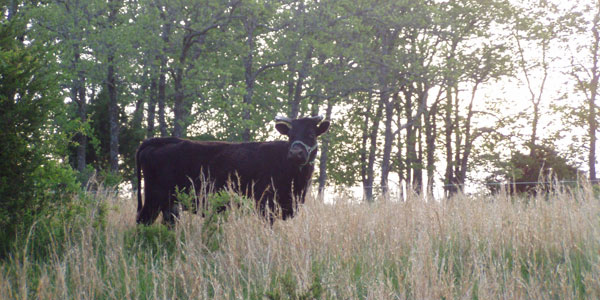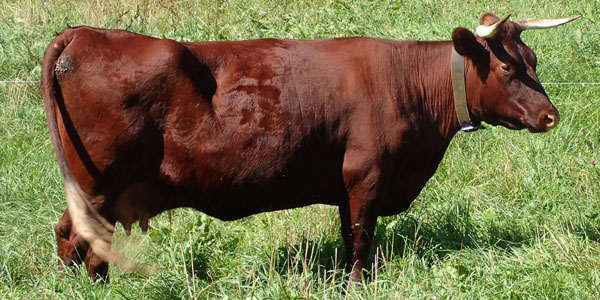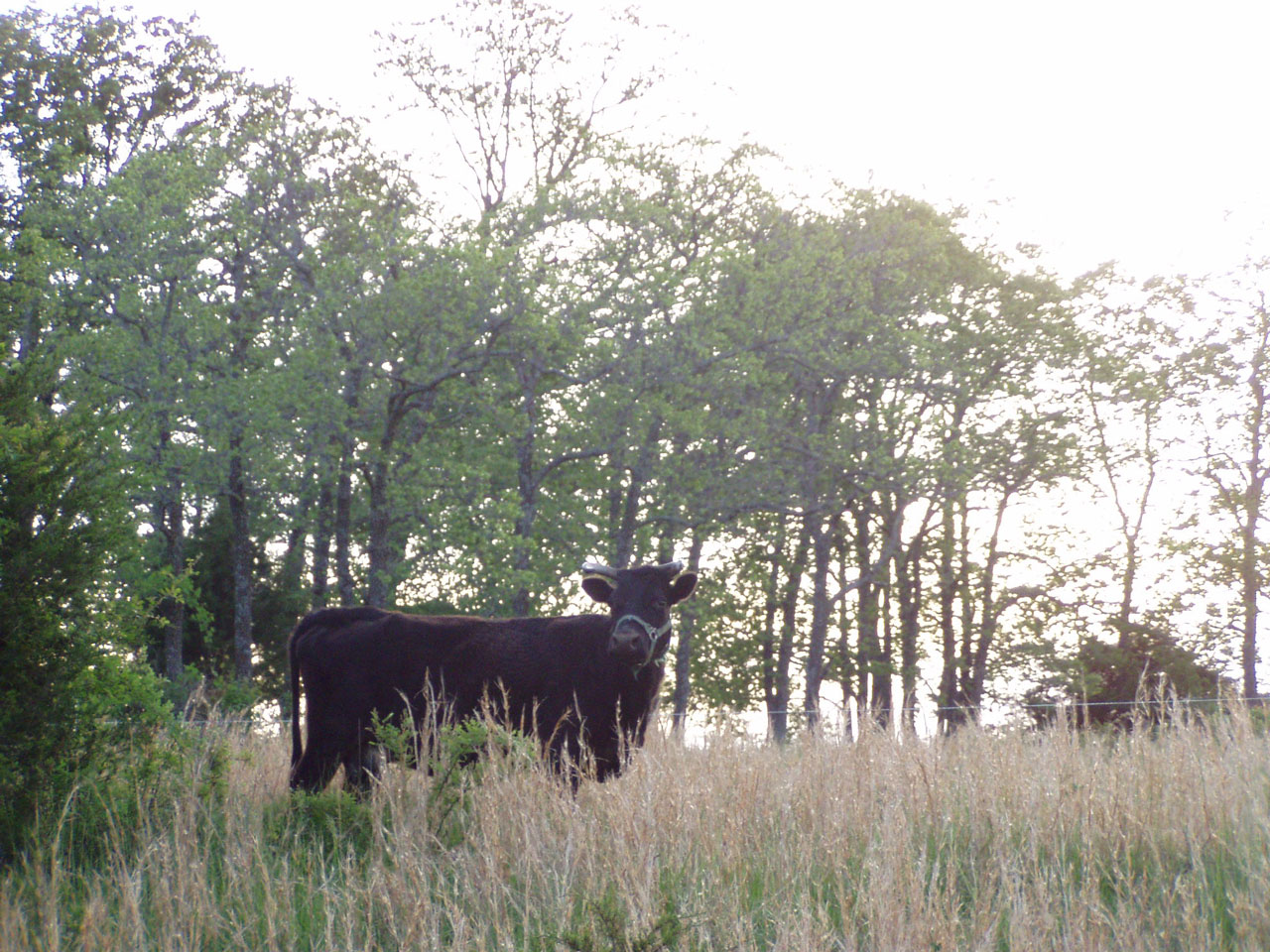
Gail
Gail
by Wesley Hunter of Seymour, MO
At the end of the day, what is a cow? Is she just so many pounds of animal flesh, a unit in a farm management scheme, a tool to be used and discarded as needed? Is she a mere producer of calves, of milk, of meat? Is she a member of the family, perhaps, or at least of the farm? Is she a pet? At the end of the day, is she still just a cow?
These thoughts and more have been at the forefront of my mind these past few days as we deal — and, ultimately, dealt — with the decision of what to do with our beloved old boss cow Gail. Gail was 15 years old when we bought her, one of four in our starter herd of Irish Dexter cattle. I recall being drawn to her from the start, slick and black, with gracefully curving horns the nicks and scars of which beheld her age, calm, placid eyes, and, as herd boss, a perceived sense of serene self-confidence.
I’ve heard it said that the boss cow is not the lead cow, that the boss protects herself by traveling in the middle of the herd, but not Gail. Gail was boss and leader. When I needed to move the cows, all I had to do was move Gail; the rest followed without question. And yet, at the water trough or the mineral box, Gail was in charge, and everyone else deferred to her.
But sometime in the past few months she injured her hip and in short order ceased to lead — yet she never ceased being the boss. When I would bring the other cows up to the barn for milking, Gail, in her limited mobility, would park herself at the gate leading into the corral, exercising her authority and letting the other cows through only as she saw fit. Nevermind that they were years younger, spry, and with horns of their own; they knew their place. And although I say that she ceased to lead, I can only truly say that in a limited sense. No, she was no longer in front of the line, but what of this: Gail spent her last night on this earth in the corral alongside the barn. This was to give her rest, to avoid making her negotiate the steep hills between pasture and barnyard one last time. As my wife and I stood there watching her, observing closely, grasping at any reason we could think of why she shouldn’t be killed (if she were bred last time she came into heat, although she has missed a few in a row, she’d be due to calve in only six months; maybe she limps not from pain, but because her hip healed back oddly and just doesn’t function smoothly; her eyes are still so bright and true, and look how she holds her head!; dammit, I’m not ready for her to be gone!), she was all the time bellowing to the rest of the herd, who were down the hill, around the bend, across the creek and through the trees, grazing lush clover in the cool of the summer evening. My wife went back to the house to get the kids ready for bed, leaving me with space and, I think, time to say goodbye. As I stood there with Gail, one by one up came the rest of the herd, coming to be where they were supposed to be: with Gail, the leader. They were still there in the morning.
Of our 11 cows and heifers, only two are currently in milk: Rose and Solstice. (Seven are due to calve soon — six first-calf heifers and one with her second.) After morning milking, I put them in the corral so Gail wouldn’t have to spend her last hours alone — cows are herd animals, after all. And during milking another cow, Bree, managed to escape into the yard, so I rounded her up into the corral as well. I thought no more of this until I went back out to the barn shortly before the custom on-farm mobile slaughterhouse was to arrive and looked into the side of the lean-to shed, and there they were: Gail, Bree, Rose, and Solstice, the original four cows I bought. The cynic in me says this is an irrelevant coincidence, meaningless, but I couldn’t help but find it poignant and touching. Maybe it’s a mere coping mechanism that makes me see it in such a light, but I don’t know that it matters much.
My wife and I stayed up late the night before, talking over options, discussing what-ifs. If she was bred after her last observed heat cycle, she’d be due in late January, only six months away. But can we conscientiously ask her to give us another calf, to raise and wean it, to go through another winter, to give us another year of her already long life? But as good as she still looks, should we not give her the benefit of the doubt? At 18 she’s an old, old cow, though cows have lived longer. Maybe it’s best to kill her now while she’s still in good shape, rather than risk debilitating illness or injury. But we just don’t know what the future might hold, and of course we can’t know. And if she is, in fact, currently in calf, what if she miscarries between now and January? What if she dies during labor? Is it worth taking the chance on a cow this old? And why didn’t she get bred a few months prior when she first came into heat again?
In the end, of course, we opted to go through with the on-farm slaughter, and we were ultimately happy with the choice. The man who came out, named Don, did a respectable and respectful job, clean, efficient, and worth every penny. We paid him $140 — $20 above his asking price — plus a bagful of freshly picked pears. That was $110 and a bagful of pears more than it would have cost at the local abbatoir, but it assured that Gail was able to die with dignity, head down munching oats and alfalfa in the barnyard rather than undergoing the stress of being loaded on a trailer, driven 15 highway miles to the butcher, unloaded, run through the chutes and such before finally being dispatched as just another beast on another day. She was oblivious to everything but the oats and alfalfa when the shot rang out. She dropped like a rock and bled freely when cut. I cried. After she was skinned and eviscerated Don noted that there was no calf. I was relieved, and thanked God for it. We did the right thing.
I’ve always loved animals and been fascinated by them. I studied our old World Book Encyclopedias as a kid and could tell a marten from a weasel from a mink in 4th grade or so. I went into college as a biology major, thinking I’d focus on animal studies and go to work at a zoo or some such, but quickly became disenchanted with what I saw as tedious course work and limited room for electives and changed my major to philosophy & religion. A few years after graduation, with an unmarketable degree under my belt, I realized the call to farm and became reacquainted with my love of animals. But until the past few days, I never realized how emotionally tied to it I am. And I wonder: does this make me a bad farmer, to be this saddened by the loss of an animal? Or, maybe, does this make me a good farmer, to be this concerned about the lives of my stock? Because there are no two ways about it: I killed a good animal. How can this not cause anguish?
I am reminded thus of the essay by Wendell Berry titled “A Few Words for Motherwood,” in which Mr. Berry states that, although he knows the reasons against keeping “female animals that need help in giving birth,” he always winds up “a little grateful to the ones that need help.” And so I think that with a small herd and the emotional connections that perhaps inevitably follow, that I am in some way at least grateful for the pain that accompanies difficult decisions. What kind of farmer would I be if cow number 47 was just one of dozens, if the only way I could tell her from any other cow was by the number on her ear tag? How could I reasonably care for such an animal? How could I possibly care about her?
All of the above was written in July 2014, a year and a half ago, and it surprises me a bit to look back at what I wrote then and remember how difficult it was at the time. But life, of course, goes on. And time does, in fact, heal all wounds.
We picked the packaged meat up from the butcher about a week after Gail was killed, and in short order we were using terms like “ground Gail” and “Gail steaks” to describe what was for dinner. The meat was perfectly edible and quite tasty, though much of it was predictably tough and chewy, and my wife made frequent use of the pressure cooker to good effect. We had Gail burgers often, and Gail stew was frequently seen. We sold half the meat to friends — who were well aware of the requirements for cooking really old beef — for enough to just cover the slaughter and butcher fees, a deal for them and a deal for us. And while we finished the last of the ground beef from the freezer, I decidedly felt that I wish we hadn’t sold the other half, that we would get to remember Gail and her contributions to our farm that many more times. But how fitting that her last work was to continue to sustain us, a cause she gave herself for even while she was alive. And Gail’s skull — gracefully curving horns intact — is hanging from a support post in one of the barnyard sheds, a consistent reminder.
And so I return to the questions I started with, and I’m still not sure what my answers are. A cow is a tool in grassland management, a producer of calves, milk, and meat. Our cows utilize our forages, making a rough Ozarks hill farm profitable. They give us milk, or use their milk to raise calves. In time, they give us beef. We care for them not unlike members of the family, and acknowledge their roles as members of the farm. But they are decidedly not people and, in some sense, at the end of the day a cow is still just a cow. Ultimately, I think, there is no clean, easy answer; there should be a certain amount of tension, in this and in all aspects of farming and, indeed, life in general. This is what keeps us striving for improvement, gives us balance, and at the end of day assures us that we have done our best.






